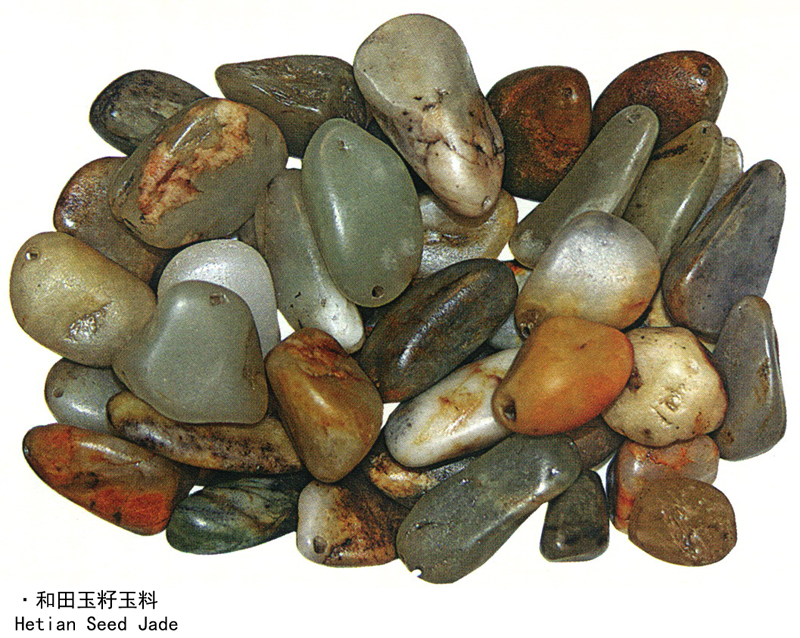丝路概说
- 交通路线
- 长安与丝绸之路
- 从长安到罗马——汉唐丝路全程探行纪实上
- 从长安到罗马——汉唐丝路全程探行纪实下
- 海上丝路史话
- 丝绸之路史研究
- 早期丝绸之路探微
- 早期丝绸之路文献研究
- 中西丝路文化史
- 沧桑大美丝绸之路
- 传播友谊的丝绸之路
- 路途漫漫丝貂情——明清东北亚丝绸之路研究
- 世界的中国——丝绸之路
- 丝绸之路
- 丝绸之路寻找失落的世界遗产
- 丝绸之路2000年
- 丝绸之路——从西安至帕米尔
- 丝绸之路经济带发展报告2014
- 丝绸之路考古十五讲
- 丝绸之路——神秘古国
- 丝绸之路——沿线城镇的兴衰
- 丝绸之路在中国
- 丝路景观
- 丝路起点长安
- 丝路文化新聚焦
- 丝路之光——创新思维与科技创新实践
- 中国丝绸之路交通史
- 中华文明史话-敦煌史话
- 中国·北海合浦海上丝绸之路始发港理论研讨会论文集
- 丝绸之路
- 丝绸之路新史
- 西域考古文存
- 丝绸之路的起源
▲和田
作者:方明





和田地区位于新疆维吾尔自治区的南部,古称“于阗”,意为“产玉石的地方”。古时的和田地区是西域36国中的于阗、皮山、渠勒、精绝、戌卢等诸国所在地。到了清代,于阗更名为“和阗”,1959年“阗”字简化为“田”字,和阗改称“和田”。古时的和田地域广阔,物产丰富,居民以农业、种植业、畜牧业为主,是西域最早获得中原养蚕技术的地区,盛产桑麻、玉石、丝绸、地毯等。
和田地区是中国最早引进佛教的地区之一。早在公元前1世纪,佛教就传入于阗,使这里逐渐成为西域最早的佛教文化中心之一,被称为“佛国于阗”。著名的高僧如晋代法显法师、唐朝玄奘法师等都在此留下了足迹。佛国于阗的昌盛,留下了众多古城和佛教遗址,如尼雅遗址、特约干遗址等,出土了大量珍贵的文物。11世纪,随着伊斯兰教东进,和田地区逐渐信仰伊斯兰教。
和田土地肥沃,阳光充足,特别适合桑蚕的养殖,是丝绸之路上著名的丝绸之乡,是新疆最早的蚕桑基地和锦绢生产重镇。考古证明,早在2000多年前,和田人就已经掌握了养蚕、抽丝、染色等工艺,丝绸贸易十分繁荣。“艾得丽丝绸”是和田的特产,汉语俗称“和田花绸”,意为“扎染的丝织品”。其质地柔软,轻盈飘逸,色彩艳丽,采用古老的扎染法制成,图案奔放粗犷,富于变化。
和田还是著名的“毯乡”。早在唐代,长安城中就有经营和田毡毯的店铺。清代,和田地方官吏向朝廷进贡的贡品中就有和田地毯。和田地毯绚丽夺目,色调高雅,图案别致,表现出维吾尔族的艺术特色以及东方情调,具有很高的实用价值。
和田地区最著名的特产还要数和田玉。早在新石器时代,和田人就发现了蕴藏在昆仑山上的美玉,并将和田玉作为中国西部与中部及东西方文化交流和经济往来的媒介,和田玉运输通道形成了中国最古老的“玉石之路”。玉石之路先于丝绸之路1000多年出现,可以说是丝绸之路的前身。西汉时期,张骞正是在玉石之路的指引下到达西域各国,开辟了丝绸之路。此后,玉石之路更加顺畅,商贩们从中原向西域运去大量的丝绸和药材,归来时又带回大量的玉石和当地特产,朝廷在甘肃驿站设置“玉门关”,意谓玉石到此便是进入国门了。
>Hetian
Located in the southern part of Xinjiang Uygur Autonomous Region,Hetian area was Known as〝Khotan"in ancient times,meaning〝land of jade".The area hosted some of the thirty-six Western Region countries such as Khotan,Pishan,Qule,Jingjue,Xulu.In the Qing Dynasty,Khotan changed its name to〝Hetian"in 1959,the character Tian was simplified to its current format.Hetian in ancient times enjoyed vast land and rich resources.The residents there mainly engaged in agriculture,farming and animal husbandry.Hetian was the first area of the Westerns Regions that acquired the sericulture technology from the Central Plains.The area produced mulberry,hemp,jade,silk,carpets,etc.
Hotan area was one of the areas where Buddhism was introduced earliest in China.As early as during the 1st century B.C.Buddhism was introduced to Khotan which became one of the earliest Buddhist cultural centers in the Western Regions.Khotan was known as〝Buddhist Kingdom Khotan".Famous monks such as Faxian of the Jin Dynasty,Xuanzang of the Tang Dynasty and others had all left their footprints in Khotan.The prosperity of Buddhist Kingdom Khotan left many ancient towns and Buddhist sites,such as the Niya Ruins,the Teyuegan Ruins,where a large amount of precious cultural relics were unearthed.In the 11th century,with the eastward spread of Islamism,people in Hotian area gradually converted to believe in Islamism.
With fertile land and adequate sunshine,Hetian was very suitable for sericulture development.As a famous town for silk on the Silk Road,Hetain was the earliest production base of sericulture in Xinjiang and brocade and fine silk producing center.Archaeological findings proved that as early as 2000 years ago,Hetian people already mastered the process of sericulture,spinning and dyeing.Silk trade flourished.Atlas silk is a specialty of Hetian.In Han Chinese,it is commonly referred to as〝Hetian flowery silk",meaning〝tie-dyed silk".Its soft texture and gorgeous colors are made using the old tie-dye method.It is light and elegant with unrestrained and rough patterns of many variations.
Hetian is also known as the hometown of〝carpets".As early as during the Tang Dynasty,there were shops dealing in Hetian felts and carpets in Chang'an.During the Qing Dynasty,local officials from Hetian included Hetian carpets in the list of tributes to the imperial court. Hetian carpets have eye-catching colors,elegant tones,delicate patterns,exuding unique Uygur artistic styles and oriental charm,and have high practical value.
The most famous specialty of Hetian area is jade.As early as during the Neolithic Period,Hetian man found gem quality jade in the Kunlun mountain and made it a media for communication between central and western China,as well as for East-West cultural and economic exchange.Transport passage for jade from Hetian emerged as the oldest〝Jade Road",some 1000 years earlier than the Silk Road.It can be said that the Jade Road was the predecessor of the Silk Road.During the Western Han Dynasty,Zhang Qian who traveled to Western Region countries and opened the Silk Road was guided by the Jade Road in the first place.Since then,the Jade Road became all the more smooth.Central Plain merchants shipped to Western Regions large amount of silk and medicinal herbs and brought back jade and native products from the Western Regions on their return.The imperial court built in Gansu the Yumenguan(Jade Gate)Pass,implying that the jade is entering the country as of this pass.
尼雅遗址与精绝古国
尼雅遗址位于和田民丰县正北约150公里的塔克拉玛干沙漠之中,1901年由英国人斯坦因发现。斯坦因在这里收集了大量的汉代文书及陶器、木雕、钱币等珍贵文物,轰动了世界考古界。直到20世纪30年代前,人们一直无法断定这个古遗址的名称,直到后来在此地发现了几枚汉简,人们才知道这里就是西域三十六国之一的精绝国。整个遗址分布在尼雅河下游的三角洲上,以两米多高的佛塔为中心,南北长25公里,东西宽7公里,有寺庙、民宅、窖址、墓地、果园、林带、道路、水池等遗迹200多处。精绝古国疆域虽小,但由于所处的地理位置非常重要,因而繁华富庶,也成为周边各势力争夺的目标。公元3世纪前后,这个国家就逐渐从人们的视野中消失了。唐代玄奘法师前往印度时曾路过精绝国遗址,在《大唐西域记》中记载道,尼雅城“周三四里,在大泽中,泽地热湿,难以履涉,芦草荒茂,无复途径。”
The Niya Ruins and the Ancient Jingjue Kingdom
Located in the Taklimakan Desert one hundred and fifty kilometers north of Minfeng County of Hetian,Niya Ruins were first discovered by a British named Stein in 1901.Stein collected a lot of precious relics of the Han Dynasty including documents,pottery,wood carvings,coins and others,causing a sensation of the world's archaeological community at the time.People were unable to unveil the identity of these ancient ruins until the 1930s,when several Han Dynasty letters were discovered among the ruins.Since then,people realized that the ruins were left by the Jingjue kingdom,one of the thirty-six countries in the Western Regions.The ruins spread over the Niya River Delta,with a two-meter-high stupa as the central landmark.The ruins cover an area of twenty five kilometers from north to south,and seven kilometers from east to west.More than two hundred sites can be found within the area including temples,houses,cellars,cemeteries,orchards,forests,roads,pools,etc.In spite of the small territory,Jingjue kingdom became rich and prosperous because of its strategic position.At the same time,it became a target for neighboring forces to compete for.Around the time of the 3rd century,the kingdom gradually disappeared from people's vision.The Tang Dynasty monk Xuanzang who traveled to India passed the Jingjue Kingdom.In his book〝Buddhist Records of the Western World,the master monk described the Niya City as〝surrounded by marsh,the weather is hot and humid,it is difficult to travel on the marshland.With lots of weeds and grass,one cannot find the way back."
丝绸之路/方明编著.-合肥: 黄山书社, 2013;